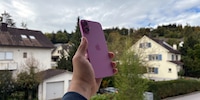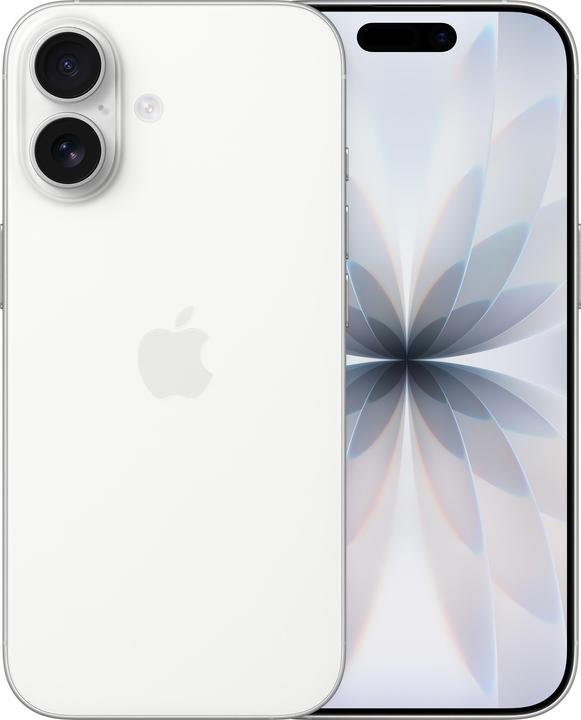

iPhone 17 review: are my Plus days over?
Apple’s iPhone 17 goes beyond expectations: more display power, better feel, and clever camera features. Anyone who thinks the basic model is a compromise will be proven wrong this year.
«Same procedure as every year» is probably one of the most famous quotes in film history. It comes from the «Dinner for one» sketch, which airs here every year on New Year’s Eve. That’s what gossips also say about the annual Apple keynote. But this year it’s only partially true: Apple’s launching the new iPhone Air and letting my beloved Plus model bite the dust. That’s why I have the basic model to test this year. Here’s a little spoiler for you: this year, the «small» iPhone is getting pampered with features – from the display to the system on a chip (SoC) and the charging standard (Qi2).
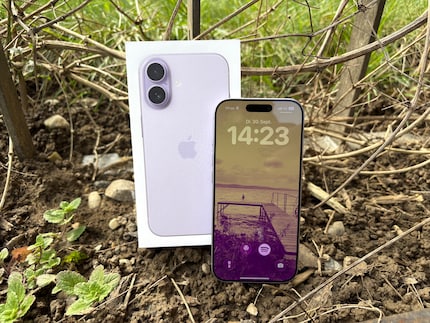
Apple took its time, but did it right: 120 hertz!
In my opinion, the display has had the biggest upgrade when compared to its predecessor. For the first time, Apple has equipped the base model with a 120 Hz panel. Right from unlocking the display, I feel like the transition is smoother than on the 16 Plus. Even scrolling through long Spotify playlists is fun. I’ve caved already, and I don’t want to go back. A 120-hertz display is something you don’t know you want until you have it (so either now, last year, or – as an Android user – for a good five years).
The resolution is 2622 × 1206 pixels. For a 6.3-inch screen size, that gives you a pixel density of 466 ppi. Texts appear razor-sharp, photos show fine lines and details. The LTPO AMOLED panel delivers rich black tones and a high contrast.
Plus, the display’s way brighter than its predecessor: the peak brightness hits 3,000 nits, while the iPhone 16 only reaches 2,000. All the display content remains easily readable, even in direct light. The cool thing is, adaptive brightness automatically dims in the evening to almost zero nits, which is much easier on the eyes. The always-on display is also a new feature of the base model. And I use this more often than I thought. The time and notifications are always visible without having to «wake up» the device. Plus, it actually uses less power than you’d expect.
Don’t underestimate it: the surface feels great
When you pick up a device dozens of times a day, its feel is super important. For me, there’s quite an obvious difference to the Plus series. Even though the display of the base model has grown from 6.1 to 6.3 inches, it still feels smaller than my 6.7-inch iPhone 16 Plus.
The case of the iPhone 17 is made from an aluminium frame, and its front and back are made of tempered glass. Glossy finishes are a thing of the past. This back is matte, and I’m not sad about it because the device is less prone to fingerprints and offers noticeably more grip. The look and feel of the back is also nice.
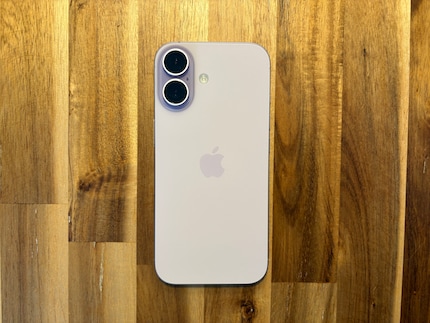
With a thickness of about 7.8 millimetres and a weight of 177 grammes, the device feels compact and comfortable to hold – even though my hands aren’t exactly big, it feels quite small to me. That’s probably because I’ve been using the Plus model for several years now. What’s interesting is that the 17-inch model is two millimetres bigger, but 0.1 millimetres narrower than its predecessor – despite having a 0.2-inch larger screen diagonal. In other words, you have a better screen/body ratio and a slimmer bezel (frame).
The connection between the frame and glass are milled precisely, without any sharp edges, unlike what you might find with the 12 and 13 models. The side controls – volume buttons and mute switch – are made of metal and respond with a short, clearly defined pressure point. The camera island, which sticks out a few millimetres from the case and makes the device a bit wobbly when lying down, is still there. Though, the case I’m using rectifies this anyway. Unlike those Yanks, we Europeans still get our SIM slot on the side. There’s also a USB-C port at the bottom. The device is certified to IP68, which guarantees complete protection against dust and water resistance for up to 30 minutes at a maximum depth of six metres.
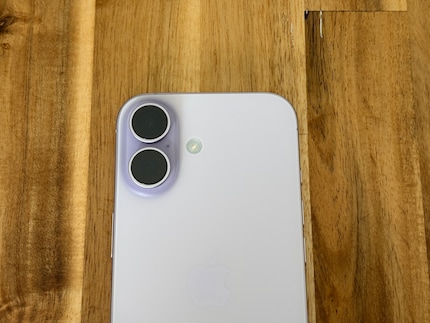
Cameras just can’t match the Pro
Even when the main camera’s fitted with 48 megapixels (MP), the standard shot’s 24 megapixels – because of pixel binning. Here, four pixels are joined to make a larger one. This enables detail-rich photos with less noise, even in bad light. Tiny things like leaves, wood or similar are clearly recognisable. Colours are neutral too: a blue sky doesn’t turn turquoise and skin tones are authentic.
When it’s dark, the aperture of the camera automatically opens up to (f/1.6), capturing a lot of light. The shutter speed automatically increases, ranging from a quarter to one full second. Objects that move are very difficult to photograph. Still life, on the other hand, turns out well: the camera could capture lots of details in my lantern scene.
In complete darkness with only isolated points of light, the software even extends the exposure time to three seconds. With a tripod, the iPhone 17 almost becomes a night vision device: cracks in the asphalt, structures in facades, even stars in the sky become visible.
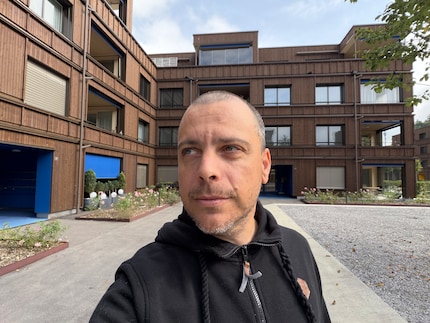
In daylight, the ultra-wide-angle camera is a useful addition, say for group photos or larger scenes. With its angle of view around 120 degrees, it captures everything in the frame. Although the landscape is slightly distorted, the blurring at the edges is less than in previous generations. Straight lines remain straight. In low light, I notice the disadvantage of the smaller aperture (f/2.2) because the edges become slightly softer. Nevertheless, the street lamp photo has turned out well here too. Faces remain recognisable.
Vlog mode: dual capture for commenting on a video
During the day, the front camera takes razor-sharp selfies. With the 18 MP resolution, hair, skin structures and even small reflections in your eyes can be captured in great detail. Your face is clearly depicted, the software works in the background and adjusts something. Exposure time increases at night, the image becomes somewhat «noisier» despite the longer exposure time in night mode.
Nevertheless, the quality’s still good enough to rub your friends’ noses in beach pictures via WhatsApp or to make your Insta followers happy. Filming is also fun, especially the new dual-capture function. I can film my surroundings and myself at the same time in 4K and up to 30 fps. This is cool for vlogging or simply commenting on certain events. There’s no jerking and it doesn’t cut out.
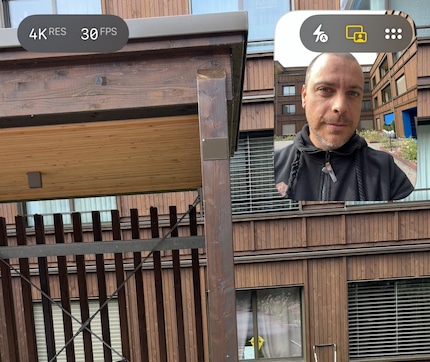
My new favourite feature: horizontal selfies
If you take a selfie horizontally, it always requires a good deal of finger acrobatics. You have to hold the phone and press the button with one finger. But don’t apply too much pressure, otherwise the phone will shift. Now, you’re able to hold the device vertically in your hands and still take a horizontal selfie. All you have to do is press «rotate automatically» option, thanks to the square sensor.
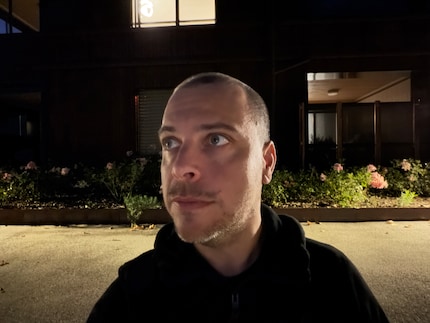
A19: why choose a Pro? I don’t know
Apple has also installed the new SoC A19 in its base model. Gone are the days when, as the owner of a «standard» iPhone, you had to make do with a chip from the previous year. The difference to the Pro and Air: you get the A19 Pro chip. What’s the difference in that? You have more system cache. Theoretically, the cache is there to ensure that stored data can be retrieved quicker. This saves time and battery. Whether you really notice this on a smartphone is another matter. I think this is more for benchmark spec nerds.
Plus, the Pro version of the chip offers one more GPU core, i.e. seven instead of six. In gaming, this could theoretically provide a performance boost for graphics-intensive games, or save a second or two when exporting a video if you do this on your smartphone. However, you won’t notice this in everyday life – especially not as long as AI plays such a subordinate role in Apple’s system. Speaking of the future, the iPhone 17 supports Wi-Fi 7, so it’s ready for the next few years with data rates supposedly reaching up to 46 Gbit/s.
Where you’re more likely to notice a difference is in comparison with predecessor models. In the CPU Geekbench 6 benchmark, the iPhone 17 achieved 3,703 points in single-core (iPhone 16 Basic: 3265) and around 9,343 points in multi-core mode (iPhone 16 Basic: 7894). In the GPU test, the phone achieved 37,194 points (iPhone 16 Basic: 28;061).
Battery: lasts a long time, still charges a little slowly
I was particularly intrigued by the battery – as a long-time Plus user, I had my doubts. The iPhone 17 comes with a 3,692 mAh battery. This may not sound like much for specs fanatics, but Apple has optimised its software accordingly. In everyday life, a full charge easily lasts from 7 a.m. to 11 p.m. – even with intensive use of the camera, navigation, music streaming and messaging, there’s often 20 to 30 per cent left. With moderate use, I occasionally even manage two days, for example on a quiet weekend. The only thing that really drains juice is using a hotspot. My benchmark test resulted in a duration of 27 hours and 39 minutes (video stress test). Apple quotes that it’ll last «up to 30 hours» here, which I can confirm with some happiness.
Where Apple’s still hesitating and dithering is the charging speed. When using a USB-C power adapter, the device needed just under 100 minutes from 0 to 100 per cent in my test. It takes less than half an hour for the first half, while the iPhone takes longer for the second 50 per cent.
For the first time, wireless charging works with the Qi2 standard at a theoretical peak power of 25 watts. On classic first-generation Qi pads, it’s only 7.5 to 15 watts. So this is more for when you’re sitting at your desk all day and have your iPhone lying next to you anyway. The good thing about the Qi2 standard is that it has magnets in, so the iPhone sits firmly on the mat.
In a nutshell
Trust me, you want the standard iPhone
With the iPhone 17, Apple is demonstrating that «basic» by no means equals «downgraded». The new 120 Hz display is a real game changer – smooth, sharp, and so bright that you can still read everything, even in full sun. You also get nice extras like the always-on display or white point reduction. The feel is spot on: light, grippy, and finally free from fingerprints. The camera takes great photos during the day, is surprisingly fun at night, and brings a fresh breeze with dual capture or horizontal selfies. Thanks to the A19 chip, the smartphone runs like a Pro without the extra cost. The only drawback is that charging still takes a while. All in all, the iPhone 17 is a strong statement – you get a premium feeling without the «Pro» label.
Pro
- 120 Hz display
- Strong cameras with dual capture
- Solid battery
Contra
- Charging is quite slow
- Loading speed rather slow

I've been tinkering with digital networks ever since I found out how to activate both telephone channels on the ISDN card for greater bandwidth. As for the analogue variety, I've been doing that since I learned to talk. Though Winterthur is my adoptive home city, my heart still bleeds red and blue.



